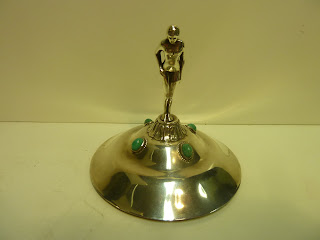It is not hallmarked being
continental, the same rigid hallmarking system was never adopted on
the British scale.
German silver is often marked 850 against
our 925 standard.
When a friend
brought it in I was impressed by the sculptural qualities of
the minute female figure standing aloft on a silver plinth flanked by four
cabochons with semi precious stones encased within.
It is only small 14 cm
high and the figure is a dainty 7cm.
The next thing I
noticed is how the lid just fits so perfectly as if there isn't a join
at all, the maker has put the join on the edge of the box so that it
is almost a secret opening. Its been thought about alright. Years of skill encompassed in such a jewel like object.
 It is hardly
surprising to find out that the maker was a master gold and silver
smith steeped in a sculptural tradition that allowed him to cast
silver to perfection, loosely and playfully echoing the prevailing
style.
It is hardly
surprising to find out that the maker was a master gold and silver
smith steeped in a sculptural tradition that allowed him to cast
silver to perfection, loosely and playfully echoing the prevailing
style.
Art Nouveau.
He did have to switch with the times when
a more modernist approach was required.
There are no fingers or facial expressions, for me, it has the qualities of a ten minute sketch by a master artist.
This is a small
work by Ernst Riegel.

Ernst Riegel was born 12 September 1871 in Münnerstadt, Franks, and died 14 February 1939 in Cologne. He was a German goldsmith, sculptor and university professor.
From an early age he was impressed by
the works of Tilman Riemenschneider and especially
of the famous winged altar in the church he saw.
In 1890 he studied sculpture and the goldsmith's art for five years at The Royal School of Applied Arts in Munich , with amongst others, Fritz Miller.
He joined the Darmstadt artists' colony in 1908 and came third in the Hesse exhibition.
In 1890 he studied sculpture and the goldsmith's art for five years at The Royal School of Applied Arts in Munich , with amongst others, Fritz Miller.
He joined the Darmstadt artists' colony in 1908 and came third in the Hesse exhibition.
He was
commissioned to make the chain of the office of the Lord Mayor of
Darmstadt and was commissioned in 1912 with the design
of the Lutheran Church in Worms.
He brought Emil Thormählen to Cologne in 1913 who, he entrusted with the management of gold and silversmithing class.
In 1926 he was appointed professor at Cologne led by Richard Riemerschmid.
He brought Emil Thormählen to Cologne in 1913 who, he entrusted with the management of gold and silversmithing class.
In 1926 he was appointed professor at Cologne led by Richard Riemerschmid.
During The World
War when the motto was "I gave gold for iron" it was
difficult to work with precious metals. After the war there was
subsequent period of massive inflation, it was almost impossible to
work with precious metals during this period.
To allow the students a realistic and practical time-and labour on materials, he initiated the establishment of a business office at the factory schools run by a commercial director.
To allow the students a realistic and practical time-and labour on materials, he initiated the establishment of a business office at the factory schools run by a commercial director.
 The aim,
through his contacts made with industry, government agencies and
private citizens was to obtain work orders and the
studios and workshops on performance of the Cologne factory schools
to make development and testing laboratories.
The aim,
through his contacts made with industry, government agencies and
private citizens was to obtain work orders and the
studios and workshops on performance of the Cologne factory schools
to make development and testing laboratories.His plan worked: the precious metals department and the Department of Religious Art financed almost half the budget of the university.
The city of Cologne could be called a factory school.
The Lord Mayor
Konrad Adenauer awarded well-paid jobs that were, in
1929, laying the foundation stone of the new building of the
University of Cologne.
Lindenthal, the
headmaster had chains in gold and cups in silver manufactured by
Ernst with his students.
Wealthy citizens
of Cologne patronised the school - the Association of Friends of the Cologne factory
schools - placed orders thus allowing for a qualified student
education.
With the rise of the Nazis the work of the Cologne factory schools was defamed, and in 1933 a dozen artists and teachers were dismissed.
With the rise of the Nazis the work of the Cologne factory schools was defamed, and in 1933 a dozen artists and teachers were dismissed.
Among them was Ernst Riegel, "fired
with immediate effect. His successor, was Charles Berthold.
See More by clicking the link below



No comments:
Post a Comment